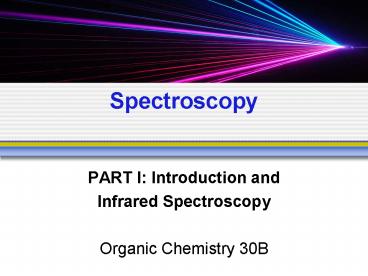Spectroscopy - PowerPoint PPT Presentation
1 / 38
Title:
Spectroscopy
Description:
Molecular Spectroscopy is the study of which frequencies of radiation are ... Symmetrical Asymmetrical Scissoring. Twisting Rocking Wagging. Bond Vibrations for CH2 ... – PowerPoint PPT presentation
Number of Views:89
Avg rating:3.0/5.0
Title: Spectroscopy
1
Spectroscopy
- PART I Introduction and
- Infrared Spectroscopy
- Organic Chemistry 30B
2
Spectroscopy
- Spectroscopy is the study of the interaction of
electromagnetic radiation and matter - Molecular Spectroscopy is the study of which
frequencies of radiation are absorbed or emitted
by a substance and the correlation of those
frequencies with molecular structure
3
Energy, Wavelength, Frequency
- Key relationships for electromagnetic radiation
- E h? hc/?
- E energy
- h Plancks constant
- c Speed of light
- ? Frequency
- ? Wavelength
4
Energy, Wavelength, Frequency
- Key relationships E h? hc/?
- Increase Frequency (?) --gt Increase Energy
- Decrease Frequency (?) --gt Decrease Energy
- Increase Wavelength (?) --gt Decrease Energy
- Decrease Wavelength (?) --gt Increase Energy
5
Energy, Wavelength, Frequency
6
Wavelength Units
7
Absorption of Energy by Molecules
8
Effects of Electromagnetic Radiation on Molecules
- Radiation Outcome
- hn 109 nm Radiowave Nuclear Spin Flips
- hn 106 nm Microwave Molecular Rotation
- hn 104 nm Infrared Bond Vibrations
- hn 500 nm Visible Electronic Excitation
- hn 200 nm Ultraviolet Electronic Excitation
- hn 10 nm X-ray Molecular Ionization
- hn 0.1 nm Gamma Ray Bond Cleavage
9
Infrared Spectroscopy
- Absorption of Infrared light in the wavelength
range of 2.5x10-6 m to 2.5x 10-5 m (2.5 ?m to 25
?m) causes bond vibrations - Specific wavelengths (or frequencies) can be
correlated with specific functional groups
10
Infrared Spectroscopy
- Infrared Spectrometer
11
Infrared Spectrum
12
Infrared Spectrum Units
Wavenumber 1/ ? ?/c
2.5 ?m 4000 cm-1
25 ?m 400 cm-1
Increase Wavenumber --gt Increase Energy Decrease
Wavenumber --gt Decrease Energy
Transmittance 100 - Absorbance
13
Bond Vibrations for CH2
14
Bond Vibrations for CH2
Symmetrical Asymmetrical Scissoring
Twisting Rocking Wagging
15
Bond Vibrations for CH2
Symmetrical Asymmetrical Scissoring
Twisting Rocking Wagging
16
Theory of Bond Vibrations
- A vibrating bond can be thought of as two masses
connected by a spring
- The frequency of vibration is given by Hooks Law
k Force Constant m reduced mass m1m2/(m1
m2)
17
Absorption Frequencies
Typical absorption frequencies for
organic functional groups
18
Functional Group Absorbances
19
Functional Group Absorbances
20
Absorption Frequencies
Typical absorption frequencies for
organic functional groups
21
IR Spectrum of Decane
22
IR Spectrum of Cyclohexene
23
IR Spectrum of 1-Octyne
24
IR Spectrum of Toluene
25
IR Spectrum of Anisole
26
IR Spectrum of Dibutyl Ether
27
IR Spectrum of 1-Hexanol
28
IR Spectrum of 1-Hexanol
29
IR Spectrum of 1-Butanamine
30
IR Spectrum of Menthone
31
IR Spectrum of Pentanoic Acid
32
IR Spectrum of Ethyl Butanoate
33
Comparison of IR Spectra
IR Spectra of t-butanol and n-butyl acetate
34
Comparison of IR Spectra
IR spectra, an IR spectra comparison tool and
spectral problems are available
at http//www.chem.ucla.edu/webspectra
35
Details of Carbonyl Groups
- CO Stretching Frequency
- Cyclohexanone 1715 cm-1
- Cyclopentanone 1745 cm-1
- Cyclobutanone 1780 cm-1
- Cyclopropanone 1850 cm-1
- Cyclohexenone 1695 cm-1
36
Details of Carbonyl Groups - 2
- Functional Group Frequencies
- Ketone CO 1630-1820 cm-1
- Aldehyde CO 1630-1820 cm-1
- C-H 2720 cm-1
- Acid CO 1700-1725 cm-1
- O-H 2500-3300 cm-1
- Ester CO 1735-1800 cm-1
- C-O 1000-1100 (sp3)
- or 1200-1250 cm-1 (sp2)
37
Interpreting Infrared Spectra
- Check for signals near 3000 cm-1
- Alkanes vs alkenes vs alkynes
- Check for signals near 3400 cm-1
- OH vs NH vs NH2
- Check for signals near 1700 cm-1
- Aldehyde vs ketone vs ester vs acid vs amide
- The principle goal will be identification of
functional groups
38
End































